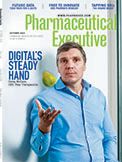Underlying Platform: Data Unleashed
Pharmaceutical Executive
In keeping pace with the digital transformation, pharma companies are doing pretty well with data and infrastructure, but a fundamental reshaping of operating models remains the biggest hurdle to moving forward.
The underlying platform, the digital transformation, the near-future future of pharma is coming together. If we use the current turn toward precision medicine to create, commercialize, and distribute customized, targeted therapies to smaller populations as our premise, then how pharma uses data, infrastructure, and advanced analytics is happening. And not slowly, but within three-to-five years, companies will have made significant progress in data integration and digital transformation, with a sophisticated data analytics overlay. But with one caveat: a company’s ability to fundamentally address its operating model and how it can transform to get past old structures.
Pratap Khedkar, managing principal, ZS Associates, believes that the pharma industry is doing pretty well in regard to data and infrastructure, but as far as the operating model and talent, companies are behind.
Pratap Khedkar

“They are getting better at data acquisition, evaluating sources, integrating the data, and using the analytics on top of the data,” says Khedkar. “And as far as the infrastructure, most have moved into the cloud or are using Amazon Web Services; but how do you get your operating model-the department, the functions, the jobs-to all work together? That is a big challenge. The C-suite has to pay attention to all of these things.”
Alan S. Louie, PhD, research director, life sciences, IDC, also thinks pharma is in a pretty good place in regard to digital transformation. “We are at that point where data needs to be more accessible, and it’s not too bad,” he says. “All the data isn’t going into a magical data warehouse or, say, a country-specific warehouse for your regulators on one hand, or clinical and commercial on another.”
Louie describes a not-so-distant future where IT infrastructure is going to run in the background and not be a central discussion.
“There is multi-cloud, polycloud, hybrid cloud-at the end of the day, there is no need to push all of your data needs into a single cloud or single place,” says Louie. “Of course, critical data, patient identifiable data, IP, and business-sensitive data will stay inside the firewall.”
So what is this underlying platform, if not a single entity? That’s where Khedkar says organizations get stuck, in the definition. While some large pharmas are hiring chief data officers who source, acquire, test, or partner with businesses for the right data, and chief information officers that focus on speed of getting the data enabled for analytics, the skill sets related to analyzing that data and providing immediate insights are not there.
“How do you educate a lot of people to find data and use data?” he says. “You could use a governance system, but if that becomes a bottleneck of only a handful of people who can provide the insights, then the data is not enabled and neither are the people.”
The platform, then, is the data, infrastructure, operating model, and skill sets.
Alan Louie

Louie notes there is no one best practice to getting to the digital transformation. “There are fits and starts with technology, pilots, data integration initiatives, APIs being built-and all of that is good,” he says. “Most companies are looking for transformation with specific goals, such as patient recruitment, enabling virtual trials, identifying data sources, and safety reporting. These are all advances and should be pursued. But there is no single best practice, and nothing really will become generalizable until someone comes in, puts it together, and uses it to more effectively deliver a drug to market.”
Khedkar believes that the fits and starts and pilots, too, are a must.
“There may be a thought, ‘should I wait until a technology comes along and leapfrogs what I’m doing now?’ One thing that is clear is that technology gets faster, cheaper, and easier with time,” he says. “But waiting is a risk. You will still have old skill sets, and trying to match that to even-better technology will be detrimental. But you really need to start so that you are evolving the operating model and evolving the people.”
Louie agrees. “With all the availability of data, if you wait, you are working on an old model, which is limited,” he says. “The competitive advantage is in the moving forward.”
So how can companies sustain such momentum? As mentioned, the clouds and their various formations are more than a viable technology. Hiring chief data officers and improving employee education and governance is another way to keep moving forward.
Khedkar also suggests that the C-suite decide where to make investments. Maybe you don’t want to be a discovery company, maybe you aren’t going to invent a new drug in the next few years. Using current digital transformation communicating with physicians on the commercial side can reportedly increase prescription sales 6%, not an insignificant impact to the revenue line.

For the smaller biopharma, Louie and Khedkar say by virtue of the size of these companies and nature of their business, they are well placed in the future pharma (i.e., no legacy systems; shorter time frames for data needs; if they are preclinical, there is no patient data, etc). The smaller companies can use CROs and service providers to be more agile, and use their systems for data. In addition, there is the availability of subscription-based data and dashboards that create an operating expense rather than a capital investment expense. Khedkar says large companies could even look to the rent model; it is that affordable.
Khedkar compares moving forward with the underlying platform pieces to muscle memory. If you don’t start using it and building it, it will become that much harder to start.
Lisa Henderson is Pharm Exec’s Editor-in-Chief. She can be reached at lhenderson@mmhgroup.com

Is Artificial Intelligence a ‘Product’? Products Liability Implications for AI-Based Products
April 10th 2025As the physical products we use evolve to become increasingly complex, traditional products liability frameworks may not always fit to provide remedies for harm that can result from using novel product types.